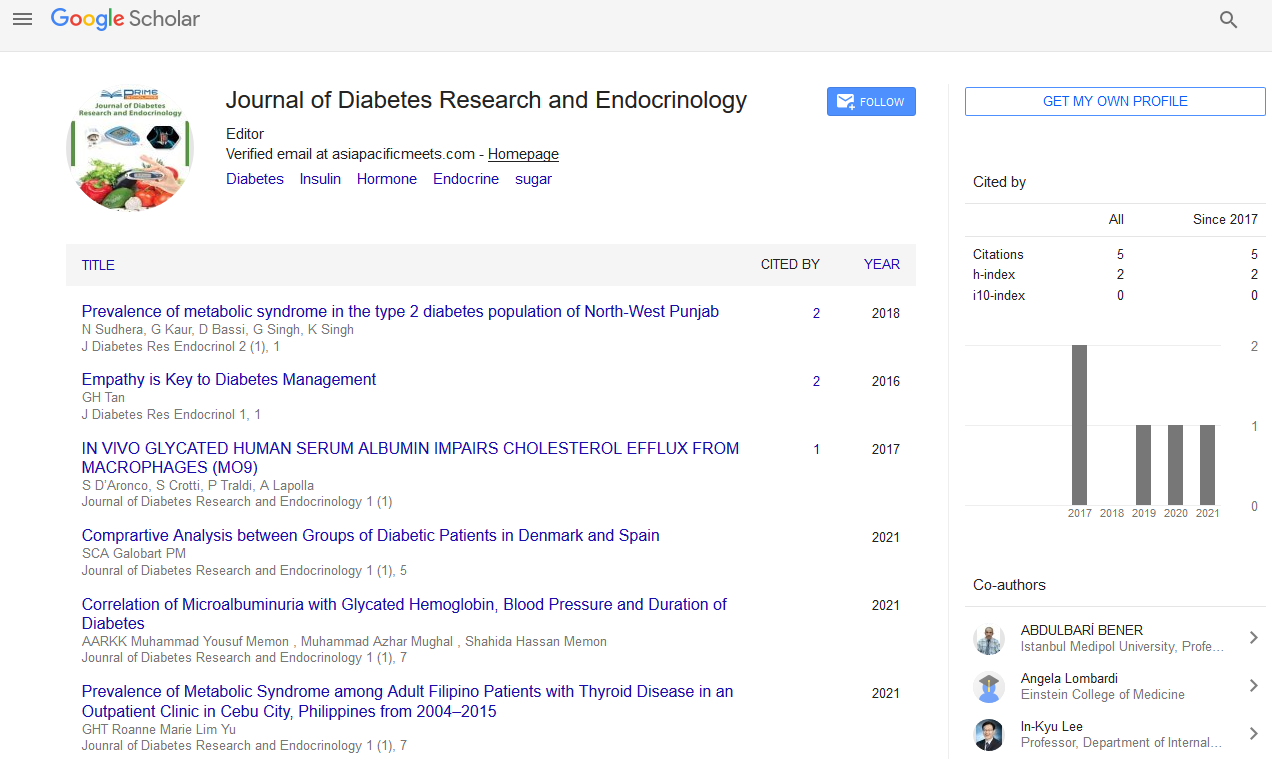Opinion - (2024) Volume 8, Issue 2
Research and Future Directions in Gestational Diabetes
Finn Marshall*
Department of Endocrinology, West of Scotland University, UK
*Correspondence:
Finn Marshall,
Department of Endocrinology, West of Scotland University,
UK,
Email:
Received: 29-May-2024, Manuscript No. IPJDRE-24-20961;
Editor assigned: 31-May-2024, Pre QC No. IPJDRE-24-20961;
Reviewed: 14-Jun-2024, QC No. IPJDRE-24-20961;
Revised: 19-Jun-2024, Manuscript No. IPJDRE-24-20961;
Published:
26-Jun-2024, DOI: 10.36648/ipjdre.08.02.20
Introduction
Gestational Diabetes Mellitus (GDM) is a condition characterized
by glucose intolerance that begins or is first recognized during
pregnancy. As the prevalence of GDM continues to rise
globally, understanding its implications and exploring future
research directions are crucial for improving maternal and
infant health outcomes. GDM typically develops in the second
or third trimester of pregnancy and affects approximately 6-9%
of pregnant women worldwide. The condition poses significant
risks to both mother and child, including increased likelihood
of preeclampsia, caesarean delivery, and future type 2 diabetes
for the mother, and higher chances of neonatal complications
such as macrosomia and hypoglycaemia for the baby. The
pathophysiology of GDM involves a combination of insulin
resistance and inadequate insulin secretion. During pregnancy,
the placenta produces hormones that can impair the mother’s
ability to utilize insulin effectively, leading to elevated blood
glucose levels. Although the exact mechanisms are complex and
multifaceted, genetic, environmental, and lifestyle factors all
contribute to the development of GDM. Advances in genomics
have led to the identification of several genetic markers
associated with GDM. Research is ongoing to understand
how these genetic variations contribute to the development
of the condition. Epigenetic studies are also exploring how
environmental factors, such as diet and stress, might influence
gene expression related to glucose metabolism. Traditional
screening for GDM typically involves glucose tolerance tests
performed in the second trimester.
Description
However, emerging research suggests that early screening,
possibly in the first trimester, could improve outcomes.
Innovative biomarkers, such as circulating microRNAs and
metabolites, are being investigated for their potential to
predict GDM risk earlier in pregnancy. The management of
GDM primarily involves lifestyle modifications, such as diet
and exercise, along with glucose monitoring and, if necessary,
insulin therapy. Recent studies are exploring the efficacy of
alternative approaches, including pharmacological treatments
like metformin and newer insulin analogy. Additionally, the
role of continuous glucose monitoring systems in managing
GDM is being evaluated for its potential to provide real-time
feedback and improve glycaemic control. Emerging evidence
suggests that gut microbiota may influence the development of
insulin resistance and GDM. Research is investigating how the
composition of the gut microbiome affects glucose metabolism
and whether interventions, such as probiotics or prebiotics,
could offer new strategies for preventing or managing GDM.
Understanding the long-term effects of GDM on both maternal
and child health is crucial.
Conclusion
These tools could facilitate real-time monitoring of glucose
levels, dietary intake, and physical activity, providing patients
and healthcare providers with valuable insights for better
disease management. GDM is a global issue with varying
prevalence and management practices across different regions.
Future research should focus on understanding regional
disparities and developing culturally appropriate strategies to
address GDM effectively in diverse populations. Prevention
remains a key goal in reducing the burden of GDM. Research
into lifestyle interventions, such as dietary modifications
and physical activity programs, and their effectiveness in
preventing GDM is essential. Additionally, exploring the
role of preconception care and early intervention strategies
could further reduce the incidence of GDM. In conclusion,
while significant progress has been made in understanding
and managing gestational diabetes, ongoing research and
innovation are essential for addressing this growing health
challenge. By exploring genetic, technological, and preventive
strategies, researchers and healthcare professionals can work
towards more effective solutions and improved outcomes for
mothers and their children.
Citation: Marshall F (2024) Research and Future Directions in Gestational Diabetes. J Diab Res Endocrinol. 8:20.
Copyright: © 2024 Marshall F. This is an open-access article distributed under the terms of the Creative Commons Attribution License, which permits unrestricted use, distribution, and reproduction in any medium, provided the original author and source are credited.

